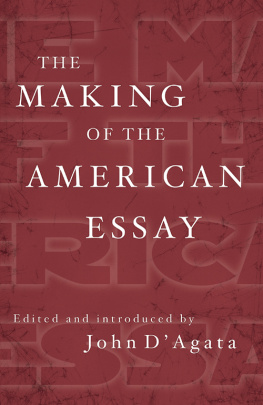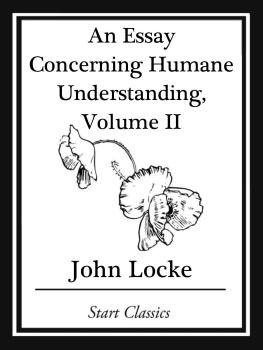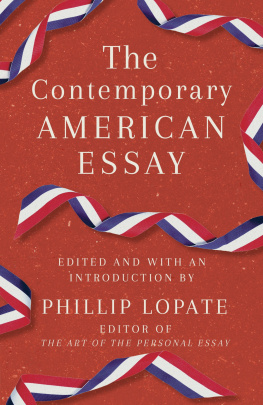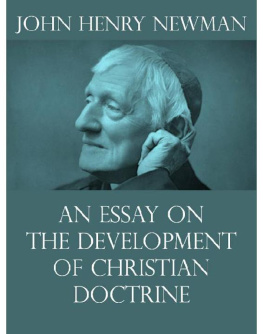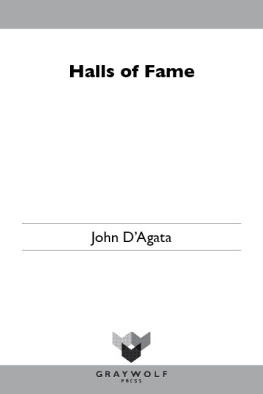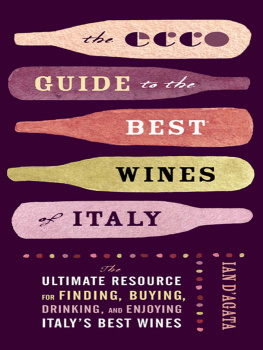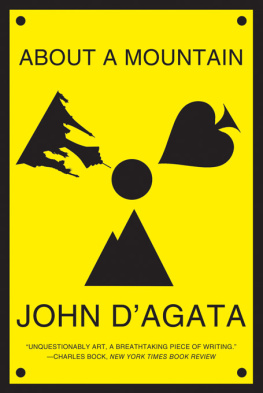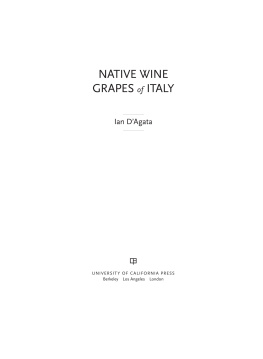John DAgata - The Making of the American Essay
Here you can read online John DAgata - The Making of the American Essay full text of the book (entire story) in english for free. Download pdf and epub, get meaning, cover and reviews about this ebook. year: 2016, publisher: Graywolf Press, genre: Art. Description of the work, (preface) as well as reviews are available. Best literature library LitArk.com created for fans of good reading and offers a wide selection of genres:
Romance novel
Science fiction
Adventure
Detective
Science
History
Home and family
Prose
Art
Politics
Computer
Non-fiction
Religion
Business
Children
Humor
Choose a favorite category and find really read worthwhile books. Enjoy immersion in the world of imagination, feel the emotions of the characters or learn something new for yourself, make an fascinating discovery.
- Book:The Making of the American Essay
- Author:
- Publisher:Graywolf Press
- Genre:
- Year:2016
- Rating:3 / 5
- Favourites:Add to favourites
- Your mark:
- 60
- 1
- 2
- 3
- 4
- 5
The Making of the American Essay: summary, description and annotation
We offer to read an annotation, description, summary or preface (depends on what the author of the book "The Making of the American Essay" wrote himself). If you haven't found the necessary information about the book — write in the comments, we will try to find it.
The Making of the American Essay — read online for free the complete book (whole text) full work
Below is the text of the book, divided by pages. System saving the place of the last page read, allows you to conveniently read the book "The Making of the American Essay" online for free, without having to search again every time where you left off. Put a bookmark, and you can go to the page where you finished reading at any time.
Font size:
Interval:
Bookmark:


Also by John DAgata
Halls of Fame
About a Mountain
The Lifespan of a Fact
A NEW HISTORY OF THE ESSAY:
The Lost Origins of the Essay
The Making of the American Essay
The Next American Essay
Edited and introduced by
Graywolf Press
Compilation and introductory notes copyright 2016 by John DAgata
The author and Graywolf Press have provided this e-book to you for your personal use only. You may not make this e-book publicly available in any way. Copyright infringement is against the law. If you believe the copy of this e-book you are reading infringes on the authors copyright, please notify Graywolf Press at: us.macmillanusa.com/piracy.
Permission acknowledgments begin on
This publication is made possible, in part, by the voters of Minnesota through a Minnesota State Arts Board Operating Support grant, thanks to a legislative appropriation from the arts and cultural heritage fund, and through a grant from the Wells Fargo Foundation Minnesota. Significant support has also been provided by Target, the McKnight Foundation, Amazon.com, and other generous contributions from foundations, corporations, and individuals. To these organizations and individuals we offer our heartfelt thanks.

Published by Graywolf Press
250 Third Avenue North, Suite 600
Minneapolis, Minnesota 55401
All rights reserved.
www.graywolfpress.org
Published in the United States of America
Printed in Canada
ISBN 978-1-55597-734-4
Ebook ISBN 978-1-55597-927-0
2 4 6 8 9 7 5 3 1
First Graywolf Printing, 2016
Library of Congress Control Number: 2015953595
Cover design: Christa Schoenbrodt, Studio Haus
Make it plain.
WHITMAN

Make it new.
POUND

Make it sweet again.
ASHBERY

One summer evening, in 1908, the hay in the fields around Folsom, New Mexico, was cut and waiting for baling. The towns two hundred residents had gone to bed that night after a light rain cleared just in time for the sunset. But by midnight, when everyone was asleep, heavier clouds settled over the mountains above the town, and soon more than twenty inches of rain began to fall. Streams of it poured down the mountains all night, rushing into the fields, gathering up the hay, and carrying it to a trestle that spanned a nearby creek. The hay clumped and clogged around the railroad bridges beams, and for a while the debris managed to chock off the surging water, but as the rain continued to fall, and as the pressure began to swell, the accidental dam of iron, mud, and hay burst onto the town, killing people in their sleep, drowning the towns livestock, crushing almost every permanent building along the way. The next morning, while surveying the floods damage, a local cowboy noticed the bones of a very large animal protruding from the creek. The flood had washed away so much of the creekbed that previously hidden layers of earth were now exposedancient, secret, long-lost layers, suggesting that the animal the cowboy came upon was not only very old but probably extinct. As he inspected the bones more closely, the cowboy noticed an arrowhead lodged between two ribs, but he couldnt figure out how an arrow had killed such an animal before it was even thought that humans lived in America. The cowboys discovery was considered so incredible, in fact, that it took over a decade before any archaeologists would come to examine it. Yet by the time they did, arrowheads in nearby Clovis, New Mexico, were found in bones determined to be even older still. And quickly thereafter, artifacts were discovered in Texas, Wisconsin, Pennsylvania, and Virginia that pushed back the date for human presence in America to 14,000 B.C.E.long preceding the Neolithic Revolution, that cultural explosion in the ancient Near East that led to the domestication of animals, the cultivation of land, the development of towns, and the beginning of civilization. What this means, say most archaeologists today, is that whatever the earliest occupants of the Americas achieved they achieved in isolation, negating the long-held belief that their only real achievement was in emigrating from the Old World with inherited skills. Indeed, the first occupants of the Americas constructed their world from scratch. They lived collectively on massive farms that they developed after clear-cutting huge tracts of land. They developed cities that held hundreds of thousands of people. They maintained an estimated twenty-five thousand miles of complex highway systems, dozens of written languages, giant athletic arenas, stone towers, observatories, libraries, schools. They created a 365-day calendar that was more accurate than any other calendar in the world. They developed the concept of zero. They perfected mummification. And in the most striking example of their independent innovations, they also invented the wheelyet they only found a use for it as a novelty in childrens toys. The obvious lesson here is that we ought to pay tribute to the talents and ambitions of Americas earliest occupants, those pioneering humans who frequently fall victim to the dreamy racist stereotype of the gentle noble savage, peacefully living in unison with an uncorrupted Earth. But I have to admit that the lesson that interests me more about our earliest American ancestors is that we all apparently have a need to shape the world around us, to build it into something new, to make it into what we want. The best illustration of this comes from a creation story from Northern California. In the mythologies of the Cahto, who live in the Pacific Coast Ranges, the world is made by two gods who spend their time designing mountains, trees, animals, and people, only to see them wiped away by a devastating flood. The flood doesnt come as a punishment, or a warning, or even as a lesson, but instead it seems to come because floods will sometimes comeleaving us with nothing but the opportunity to rebuild. So thats what the Cahto do. But before they reconstruct the world they lost in their creation story, the Cahto make a point of lingering on the details of the floods devastation, noting how it methodically disassembled the world around them by erasing each part of it, piece by piece by piece: the mountains, trees, birds, people, weather, dirt, and light. What were left with, momentarily, is just the shell of what had been there, the physical shape of nothingness, an emblem of the ineffable that were nevertheless allowed to see and smell and touch. The Cahto want us to palpably know what nothing really means, because the meaning behind Creation is creativity itself, the power and the pleasure of making. What we all have is a world, the Cahto seem to say, but what we do with it is create. To my ear, this is the predicament of every essay too, situated as essays always are between chance and contrivance, between the given and the made. The world provides nonfiction, and humans provide the rest. The essays in this anthology have an appetite for the restfor what else nonfiction can do. They are essays with a penchant for making new things, regardless of expectation, regardless of consequence. Let floods come, let dreams come, let something unexpected overtake us and make us new. The world, we all know, is already a nonfiction.
Font size:
Interval:
Bookmark:
Similar books «The Making of the American Essay»
Look at similar books to The Making of the American Essay. We have selected literature similar in name and meaning in the hope of providing readers with more options to find new, interesting, not yet read works.
Discussion, reviews of the book The Making of the American Essay and just readers' own opinions. Leave your comments, write what you think about the work, its meaning or the main characters. Specify what exactly you liked and what you didn't like, and why you think so.

